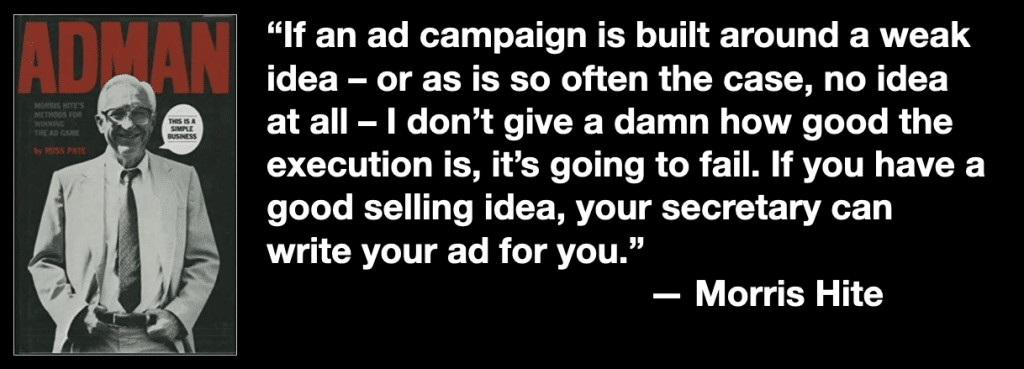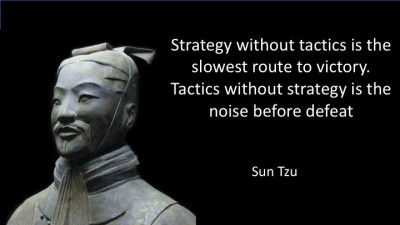
When it comes to branding, creativity is a must.
And for two reasons:
First, creativity is required to make your ads entertaining enough to hold an audience’s attention.
Second, creativity bridges the gap between telling and showing — between giving the audience information and convincing them of the truth.
And it’s the latter part that separates the men from the boys when it comes to powerful branding.
As Bill Bernbach put it:
“Be Provocative. But be sure your provocativeness stems from your product. Your are NOT right if in your ad you stand a man on his head JUST to get attention. You ARE right if you have him on his head to show how your product keeps things from falling out of his pockets.”
It all comes down to tying your creativity to your strategy.
Ad Writing vs. Ad Strategy
 Or put another way, great ad writing is all about choosing the most interesting angle of approach for making a given point.
Or put another way, great ad writing is all about choosing the most interesting angle of approach for making a given point.
And great strategy is figuring out the point that needs to made in the first place.
If you don’t start with strategy, you’ll never come up with truly effective branding ads except by chance.
Clients are usually surprised at our insistence on an in-person and on-site visit, as well as the amount of research we do on a city’s unique culture, the competitive landscape, etc.
And there often taken aback by just how frank we can be in our questions, specifically this one:
“Why aren’t you currently growing as fast as you like? In other words, why aren’t more customers already coming to you? Is it because they don’t know about you, or because they do?”
We insist on doing this research and asking these questions because we cannot begin to create effective strategy before determining the challenges we face and the obstacles to overcome.
And an unknown business faces a very different challenge than a business with an already established reputation that needs to be reframed.
Any advertising agency that doesn’t do these things and ask these types of question is cheating their clients.
An Ad Strategy Example
 Since it’s tough to teach strategy in the abstract, let’s look at these steps in light of a theoretical advertising problem.
Since it’s tough to teach strategy in the abstract, let’s look at these steps in light of a theoretical advertising problem.
Say you were hired to create a Public Service Announcement to persuade people to regularly check their fire alarm.
Most people assume their fire alarms are working, and never bother checking them.
Now, if you were a Joe-Schmo advertising creative, you would take this assignment and immediately begin to spit-ball clever or memorable ways to get this message across.
Notice that this approach hardly requires research of any kind.
Nor does it allow you to create a messaging strategy prior to jumping off into creativity and ad writing.
So the intelligent thing to do would be to ask the hard questions:
Why aren’t people ALREADY doing this?
The answer is the general (mis)perception people have that they’ll wake up in a fire and don’t need the early warning detection of a smoke alarm. Their nose works just fine, thank you very much.
The reality, which you’ll learn if you do the research, is that the toxic smoke from home fires knocks people unconscious before they even have a chance to wake up. Then their unconscious bodies suffocate in the smoke.
So now you know the obstacle to overcome — the audience’s misperception of what’ll happen during a home fire — as well as some hard hitting facts to use in developing your ad.
Strategy Is Essential — But You Still Need Creativity
 And this is where the second mistake usually gets made.
And this is where the second mistake usually gets made.
Advertisers think that simply telling people the truth is enough.
After all, the facts are on their side, right?
But if you wish to persuade, you must cause the audience to realize the truth for themselves, so that it becomes their truth.
They have to feel the truth in their guts.
This is where creativity comes into its own. But creativity tied to strategy.
And if you were to develop a creative ad based on this strategy, you might come up with something like this:
Is filming the scene underwater super creative and inherently interesting?
Absolutely. The unique angle of approach taken by this ad totally captures the attention of viewers.
But what makes it hit so hard is that it’s inherently tied to effective messaging strategy.
Creativity Tied to Strategy Means Your Brand Wins Big
If you’re new to mass media advertising, THE question you’re likely asking yourself is:
“Does this stuff really work? Does it really drive huge success, in a reliable repeatable way?”
Answer: Yes; there are hundreds of case studies of campaigns that drove magical, mind-bending results.
And, yes, there are advertising creatives with a batting average that leaves no doubt as to whether their results were a matter of skill instead of luck.
All of which leads to the next question:
“How do I know if my ad guy has the stuff and can wield that magic?”
Answer: how much time do they spend on strategy? How much research do they do before crafting the ads? Are they asking you the hard questions?
If writing the ads isn’t the last thing they do, you should give them a pass and look for another ad guy.
- Pro Tip: Talk to Your Customers Like Friends - April 23, 2024
- Brands Are Small Things — And That’s a Good Thing! - April 16, 2024
- The Two Universal Appeals — Understanding the “Cult” of Cult Branding - April 9, 2024
